Precision Nomothetic Medicine in Depression Research: A New Depression Model, and New Endophenotype Classes and Pathway Phenotypes, and A Digital Self
Abstract
:1. Introduction
2. Methods
3. The Aims of Precision Medicine and Machine Learning
3.1. Step 1: Optimize Existing Models
3.2. Step 2: Uncover Endophenotype Classes and Pathway Phenotypes
3.3. Step 3: Towards the Personalized Approach
4. Specific Supervised and Unsupervised Pattern Recognition Methods
4.1. SIMCA: A Supervised Learning Method
4.2. PLS Path Modeling: A Supervised Technique
4.3. Principal Component Analysis: An Unsupervised Machine Learning
4.4. Clustering Analysis: An Unsupervised Learning Technique
5. Core issues in Psychiatry Which Prevent the Development of Precision Depression Models
5.1. Contemporary Depression Research Is a Chaos of Many Concepts, Diagnoses, and Labels
5.2. The Core Issue Which Undermines Progress in Precision Depression Research
5.3. The Gold-Standard Psychiatric Rating Instruments Are Impediments
6. Precision Medicine in Psychiatric Research
7. Precision Nomothetic Networks of Mood Disorders
7.1. Conceptual Framework and Validation of A New Precision Model of MDMD
7.2. Construction of Endophenotype Classes and Pathway Phenotypes within the New MDMD Model
7.2.1. New Endophenotype Classes
7.2.2. New Pathway-Phenotypes
7.2.3. Towards Personalized Medicine
8. Conclusions
Funding
Institutional Review Board Statement
Informed Consent Statement
Data Availability Statement
Acknowledgments
Conflicts of Interest
References
- Wikipedia. Precision Medicine. 2021. Precision Medicine—Wikipedia. Available online: https://cn.bing.com/search?q=Precision+medicine+-+Wikipedia&cvid=e5c3da44f05c48e086cf2d82539b0145&aqs=edge..69i57j69i64.431j0j1&pglt=129&FORM=ANNTA1&PC=U531 (accessed on 28 November 2021).
- National Research Council. Committee on A Framework for Developing a New Taxonomy of Disease. In Toward Precision Medicine: Building a Knowledge Network for Biomedical Research and a New Taxonomy of Disease; National Academies Press: Washington, DC, USA, 2011. [Google Scholar]
- Lu, Y.F.; Goldstein, D.B.; Angrist, M.; Cavalleri, G. Personalized medicine and human genetic diversity. Cold Spring Harb. Perspect. Med. 2015, 4, a008581. [Google Scholar] [CrossRef] [PubMed] [Green Version]
- Schwartzberg, L.; Kim, E.S.; Liu, D.; Schrag, D. Precision Oncology: Who, How, What, When, and When Not? Am. Soc. Clin. Oncol. Educ. Book 2017, 37, 160–169. [Google Scholar] [CrossRef]
- Yau, T.O. Precision treatment in colorectal cancer: Now and the future. JGH Open 2019, 3, 361–369. [Google Scholar] [CrossRef] [PubMed]
- Kalman, J.M.; Lavandero, S.; Mahfoud, F.; Nahrendorf, M.; Yacoub, M.H.; Zhao, D. Looking back and thinking forwards—15 years of cardiology and cardiovascular research. Nat. Rev. Cardio. 2019, 16, 651–660. [Google Scholar] [CrossRef] [PubMed]
- MacEachern, S.J.; Forkert, N.D. Machine learning for precision medicine. Genome 2021, 64, 416–425. [Google Scholar] [CrossRef] [PubMed]
- Maes, M.; Nowak, G.; Caso, J.R.; Leza, J.C.; Song, C.; Kubera, M.; Klein, H.; Galecki, P.; Noto, C.; Glaab, E.; et al. Toward Omics-Based, Systems Biomedicine, and Path and Drug Discovery Methodologies for Depression-Inflammation Research. Mol. Neurobiol. 2016, 53, 2927–2935. [Google Scholar] [CrossRef]
- Fernandes, B.S.; Williams, L.M.; Steiner, J.; Leboyer, M.; Carvalho, A.F.; Berk, M. The new field of ‘precision psychiatry’. BMC Med. 2017, 15, 80. [Google Scholar] [CrossRef]
- Koutsouleris, N. The Max Planck Fellow Group for Precision Psychiatry. Available online: https://cn.bing.com/search?q=Precision+Psychiatry+%7C+Max+Planck+Institute+of+Psychiatry+(mpg.de)&cvid=c2f86005ed66459ebd09a7d30e7670d3&aqs=edge.0.69i59j69i60.2096j0j1&pglt=129&FORM=ANNTA1&PC=U531 (accessed on 28 November 2021).
- Passos, I.C.; Ballester, P.; Rabelo-da-Ponte, F.D.; Kapczinski, F. Precision Psychiatry: The Future Is Now. Can. J. Psychiatry 2022, 67, 21–25. [Google Scholar] [CrossRef]
- Salazar de Pablo, G.; Studerus, E.; Vaquerizo-Serrano, J.; Irving, J.; Catalan, A.; Oliver, D.; Baldwin, H.; Danese, A.; Fazel, S.; Steyerberg, E.W.; et al. Implementing Precision Psychiatry: A Systematic Review of Individualized Prediction Models for Clinical Practice. Schizophr. Bull. 2021, 47, 284–297. [Google Scholar] [CrossRef]
- Zanardi, R.; Prestifilippo, D.; Fabbri, C.; Colombo, C.; Maron, E.; Serretti, A. Precision psychiatry in clinical practice. Int. J. Psychiatry Clin. Pract. 2021, 25, 19–27. [Google Scholar] [CrossRef]
- Al-Hakeim, H.K.; Al-Fadhel, S.Z.; Al-Dujaili, A.H.; Carvalho, A.; Sriswasdi, S.; Maes, M. Development of a Novel Neuro-immune and Opioid-Associated Fingerprint with a Cross-Validated Ability to Identify and Authenticate Unknown Patients with Major Depression: Far Beyond Differentiation, Discrimination, and Classification. Mol. Neurobiol. 2019, 56, 7822–7835. [Google Scholar] [CrossRef] [PubMed]
- Al-Hakeim, H.K.; Almulla, A.F.; Al-Dujaili, A.H.; Maes, M. Construction of a Neuro-Immune-Cognitive Pathway-Phenotype Underpinning the Phenome of Deficit Schizophrenia. Curr. Top. Med. Chem. 2020, 20, 747–758. [Google Scholar] [CrossRef] [PubMed]
- Al-Hakeim, H.K.; Almulla, A.F.; Maes, M. The Neuroimmune and Neurotoxic Fingerprint of Major Neurocognitive Psychosis or Deficit Schizophrenia: A Supervised Machine Learning Study. Neurotox Res. 2020, 37, 753–771. [Google Scholar] [CrossRef] [PubMed]
- Al-Hakeim, H.; Hadi, H.; Jawad, G.; Maes, M. Intersections between Copper, β-Arrestin-1, Calcium, FBXW7, CD17, Insulin Resistance and Atherogenicity Mediate Depression and Anxiety Due to Type 2 Diabetes Mellitus: A Nomothetic Network Approach. J. Pers. Med. 2022, 12, 23. [Google Scholar] [CrossRef]
- Almulla, A.F.; Al-Hakeim, H.K.; Maes, M. Schizophrenia phenomenology revisited: Positive and negative symptoms are strongly related reflective manifestations of an underlying single trait indicating overall severity of schizophrenia. CNS Spectr. 2021, 26, 368–377. [Google Scholar] [CrossRef]
- Maes, M.; Moraes, J.B.; Congio, A.; Bonifacio, K.L.; Barbosa, D.S.; Vargas, H.O.; Michelin, A.P.; Carvalho, A.F.; Nunes, S.O.V. Development of a Novel Staging Model for Affective Disorders Using Partial Least Squares Bootstrapping: Effects of Lipid-Associated Antioxidant Defenses and Neuro-Oxidative Stress. Mol. Neurobiol. 2019, 56, 6626–6644. [Google Scholar] [CrossRef] [PubMed]
- Maes, M.; Andrés-Rodríguez, L.; Vojdani, A.; Sirivichayakul, S.; Barbosa, D.; Kanchanatawan, B. In Schizophrenia, Chronic Fatigue Syndrome- and Fibromyalgia-Like Symptoms are Driven by Breakdown of the Paracellular Pathway with Increased Zonulin and Immune Activation-Associated Neurotoxicity. Preprints 2021, 2021050182. [Google Scholar] [CrossRef]
- Maes, M.; Schotte, C.; Maes, L.; Cosyns, P. Clinical subtypes of unipolar depression: Part II. Quantitative and qualitative clinical differences between the vital and nonvital depression groups. Psychiatry Res. 1990, 34, 43–57. [Google Scholar] [CrossRef]
- Sinigaglia, M.; Assi, T.; Besson, F.L.; Ammari, S.; Edjlali, M.; Feltus, W.; Rozenblum-Beddok, L.; Zhao, B.; Schwartz, L.H.; Mokrane, F.Z.; et al. Imaging-guided precision medicine in glioblastoma patients treated with immune checkpoint modulators: Research trend and future directions in the field of imaging biomarkers and artificial intelligence. EJNMMI Res. 2019, 9, 78. [Google Scholar] [CrossRef]
- Haque, I.R.I.; Neubert, J. Deep learning approaches to biomedical image segmentation. Inform. Med. Unlocked 2020, 18, 100297. [Google Scholar] [CrossRef]
- Curtin, L.; Whitmire, P.; White, H.; Bond, K.M.; Mrugala, M.M.; Hu, L.S.; Swanson, K.R. Shape matters: Morphological metrics of glioblastoma imaging abnormalities as biomarkers of prognosis. Sci. Rep. 2021, 11, 23202. [Google Scholar] [CrossRef] [PubMed]
- Maes, M.; Moraes, J.B.; Bonifacio, K.L.; Barbosa, D.S.; Vargas, H.O.; Michelin, A.P.; Nunes, S.O.V. Towards a new model and classification of mood disorders based on risk resilience, neuro-affective toxicity, staging, and phenome features using the nomothetic network psychiatry approach. Metab. Brain Dis. 2021, 36, 509–521. [Google Scholar] [CrossRef] [PubMed]
- Simeonova, D.; Stoyanov, D.; Leunis, J.C.; Murdjeva, M.; Maes, M. Construction of a nitro-oxidative stress-driven, mechanistic model of mood disorders: A nomothetic network approach. Nitric. Oxide 2020, 106, 45–54. [Google Scholar] [CrossRef] [PubMed]
- Maes, M.; Rief, W. Diagnostic classifications in depression and somatization should include biomarkers, such as disorders in the tryptophan catabolite (TRYCAT) pathway. Psychiatry Res. 2012, 196, 243–249. [Google Scholar] [CrossRef]
- Kanchanatawan, B.; Sriswasdi, S.; Maes, M. Supervised machine learning to decipher the complex associations between neuro-immune biomarkers and quality of life in schizophrenia. Metab. Brain Dis. 2019, 34, 267–282. [Google Scholar] [CrossRef]
- Kummar, S.; Williams, P.M.; Lih, C.J.; Polley, E.C.; Chen, A.P.; Rubinstein, L.V.; Zhao, Y.; Simon, R.M.; Conley, B.A.; Doroshow, J.H. Application of molecular profiling in clinical trials for advanced metastatic cancers. J. Natl. Cancer Inst. 2015, 107, djv003. [Google Scholar] [CrossRef]
- Maes, M.; Maes, L.; Schotte, C.; Vandewoude, M.; Martin, M.; D’Hondt, P.; Blockx, P.; Scharpé, S.; Cosyns, P. Clinical subtypes of unipolar depression: Part III. Quantitative differences in various biological markers between the cluster-analytically generated nonvital and vital depression classes. Psychiatry Res. 1990, 34, 59–75. [Google Scholar] [CrossRef]
- Derde, M.-P.; Coomans, D.; Massart, D.L. SIMCA (Soft Independent Modeling of Class Analogy) Demonstrated with Characterization and Classification of Italian Olive Oil. J. Assoc. Off. Anal. Chem. 1984, 67, 721–727. [Google Scholar] [CrossRef]
- Massart, D.L.; Vandeginste, B.G.M.; Buydens, L.M.C.; De Jong, S.; Lewi, P.J.; Smeyers-Verbeke, J. Handbook of Chemometrics and Qualimetrics; Elsevier: Amsterdam, The Netherlands, 1998. [Google Scholar]
- Hair, J.F.; Risher, J.J.; Sarstedt, M.; Ringle, C.M. When to use and how to report the results of PLS-SEM. Eur. Bus. Rev. 2019, 31, 2–24. [Google Scholar] [CrossRef]
- Ringle, C.M.; Sarstedt, M.; Straub, D.W. Editor’s comments: A critical look at the use of PLS-SEM in “MIS Quarterly”. MIS Q. 2012, 36, iii–xiv. [Google Scholar] [CrossRef] [Green Version]
- Zachar, P.; Kendler, K.S. Psychiatric disorders: A conceptual taxonomy. Am. J. Psychiatry 2007, 164, 557–565. [Google Scholar] [CrossRef] [PubMed]
- Zachar, P.; Kendler, K.S. The Philosophy of Nosology. Annu. Rev. Clin. Psychol. 2017, 13, 49–71. [Google Scholar] [CrossRef] [PubMed]
- Popper, K.R. Conjectures and Refulation: The Growth of Scientific Knowledge; Routledge: London, UK, 1962; ISBN 9781135971441. [Google Scholar] [CrossRef]
- Maes, M.; Stoyanov, D. False dogmas in mood disorders research: Towards a nomothetic network approach. World J. Psychiatry 2021, in press.
- Maes, M.; Anderson, G. False Dogmas in Schizophrenia Research: Toward the Reification of Pathway Phenotypes and Pathway Classes. Front. Psychiatry 2021, 12, 663985. [Google Scholar] [CrossRef] [PubMed]
- Kendler, K.S. Toward a philosophical structure for psychiatry. Am. J. Psychiatry 2005, 162, 433–440. [Google Scholar] [CrossRef]
- Köhne, A.C.J.; van Os, J. Precision psychiatry: Promise for the future or rehash of a fossilised foundation? Psychol. Med. 2021, 51, 1409–1411. [Google Scholar] [CrossRef]
- van Os, J.; Kohne, A.C.J. It is not enough to sing its praises: The very foundations of precision psychiatry may be scientifically unsound and require examination. Psychol. Med. 2021, 51, 1415–1417. [Google Scholar] [CrossRef]
- Horwitz, A.; Wakefield, J. The Loss of Sadness: How Psychiatry Transformed Normal Sorrow into Depressive Disorder; Oxford University Press: Oxford, UK, 2007. [Google Scholar]
- Summerfield, D. Depression: Epidemic or pseudo-epidemic? J. R. Soc. Med. 2006, 99, 161–162. [Google Scholar] [CrossRef]
- Frances, A. Saving Normal; Harper Collins: New York, NY, USA, 2013. [Google Scholar]
- American Psychiatric Association. Diagnostic and Statistical Manual of Mental Disorders, 5th ed.; American Psychiatric Publishing: Arlington, VA, USA, 2013; pp. 5–25. ISBN 978-0-89042-555-8. [Google Scholar]
- World Health Organization. ICD-10: International Statistical Classification of Diseases and Related Health Problems: Tenth Revision, 2nd ed.; WHO: Geneva, Switzerland, 2004. [Google Scholar]
- Stoyanov, D.; Maes, M.H. How to construct neuroscience-informed psychiatric classification? Towards nomothetic networks psychiatry. World J. Psychiatry 2021, 11, 1–12. [Google Scholar] [CrossRef]
- Lieblich, S.M.; Castle, D.J.; Pantelis, C.; Hopwood, M.; Young, A.H.; Everall, I.P. High heterogeneity and low reliability in the diagnosis of major depression will impair the development of new drugs. Brit. J. Psych Open 2015, 1, e5–e7. [Google Scholar] [CrossRef] [Green Version]
- Insel, T.R. The NIMH Research Domain Criteria (RDoC) Project: Precision medicine for psychiatry. Am. J. Psychiatry 2014, 171, 395–397. [Google Scholar] [CrossRef] [PubMed] [Green Version]
- Arns, M.; van Dijk, H.; Luykx, J.J.; van Wingen, G.; Olbrich, S. Stratified psychiatry: Tomorrow’s precision psychiatry? Eur. Neuropsychopharmacol. 2021, 55, 14–19. [Google Scholar] [CrossRef] [PubMed]
- Maes, M.; Plaimas, K.; Suratanee, A.; Noto, C.; Kanchanatawan, B. First Episode Psychosis and Schizophrenia Are Systemic Neuro-Immune Disorders Triggered by a Biotic Stimulus in Individuals with Reduced Immune Regulation and Neuroprotection. Cells 2021, 10, 2929. [Google Scholar] [CrossRef] [PubMed]
- Fernandes, B.S.; Karmakar, C.; Tamouza, R.; Tran, T.; Yearwood, J.; Hamdani, N.; Laouamri, H.; Richard, J.R.; Yolken, R.; Berk, M.; et al. Precision psychiatry with immunological and cognitive biomarkers: A multi-domain prediction for the diagnosis of bipolar disorder or schizophrenia using machine learning. Transl. Psychiatry 2020, 10, 162. [Google Scholar] [CrossRef]
- Bzdok, D.; Meyer-Lindenberg, A. Machine Learning for Precision Psychiatry: Opportunities and Challenges. Biol. Psychiatry Cogn. Neurosci. Neuroimaging 2017, 3, 223–230. [Google Scholar] [CrossRef] [Green Version]
- Maes, M.; Lambrechts, J.; Bosmans, E.; Jacobs, J.; Suy, E.; Vandervorst, C.; de Jonckheere, C.; Minner, B.; Raus, J. Evidence for a systemic immune activation during depression: Results of leukocyte enumeration by flow cytometry in conjunction with monoclonal antibody staining. Psychol. Med. 1992, 22, 45–53. [Google Scholar] [CrossRef]
- Maes, M.; Stevens, W.J.; Declerck, L.S.; Bridts, C.H.; Peeters, D.; Schotte, C.; Cosyns, P. Significantly increased expression of T-cell activation markers (interleukin-2 and HLA-DR) in depression: Further evidence for an inflammatory process during that illness. Prog. Neuropsychopharmacol. Biol. Psychiatry 1993, 17, 241–255. [Google Scholar] [CrossRef]
- Maes, M.; Congio, A.; Moraes, J.B.; Bonifacio, K.L.; Barbosa, D.S.; Vargas, H.O.; Morris, G.; Puri, B.K.; Michelin, A.P.; Nunes, S.O.V. Early Life Trauma Predicts Affective Phenomenology and the Effects are Partly Mediated by Staging Coupled with Lowered Lipid-Associated Antioxidant Defences. Biomol. Concepts 2018, 9, 115–130. [Google Scholar] [CrossRef] [Green Version]
- Kandilarova, S.; Stoyanov, D.S.; Paunova, R.; Todeva-Radneva, A.; Aryutova, K.; Maes, M. Effective Connectivity between Major Nodes of the Limbic System, Salience and Frontoparietal Networks Differentiates Schizophrenia and Mood Disorders from Healthy Controls. J. Pers Med. 2021, 11, 1110. [Google Scholar] [CrossRef]
- Al-Hakeim, H.K.; Mousa, R.F.; Al-Dujaili, A.H.; Maes, M. In schizophrenia, non-remitters and partial remitters to treatment with antipsychotics are qualitatively distinct classes with respect to neurocognitive deficits and neuro-immune biomarkers: Results of soft independent modeling of class analogy. Metab. Brain Dis. 2021, 36, 939–955. [Google Scholar] [CrossRef]
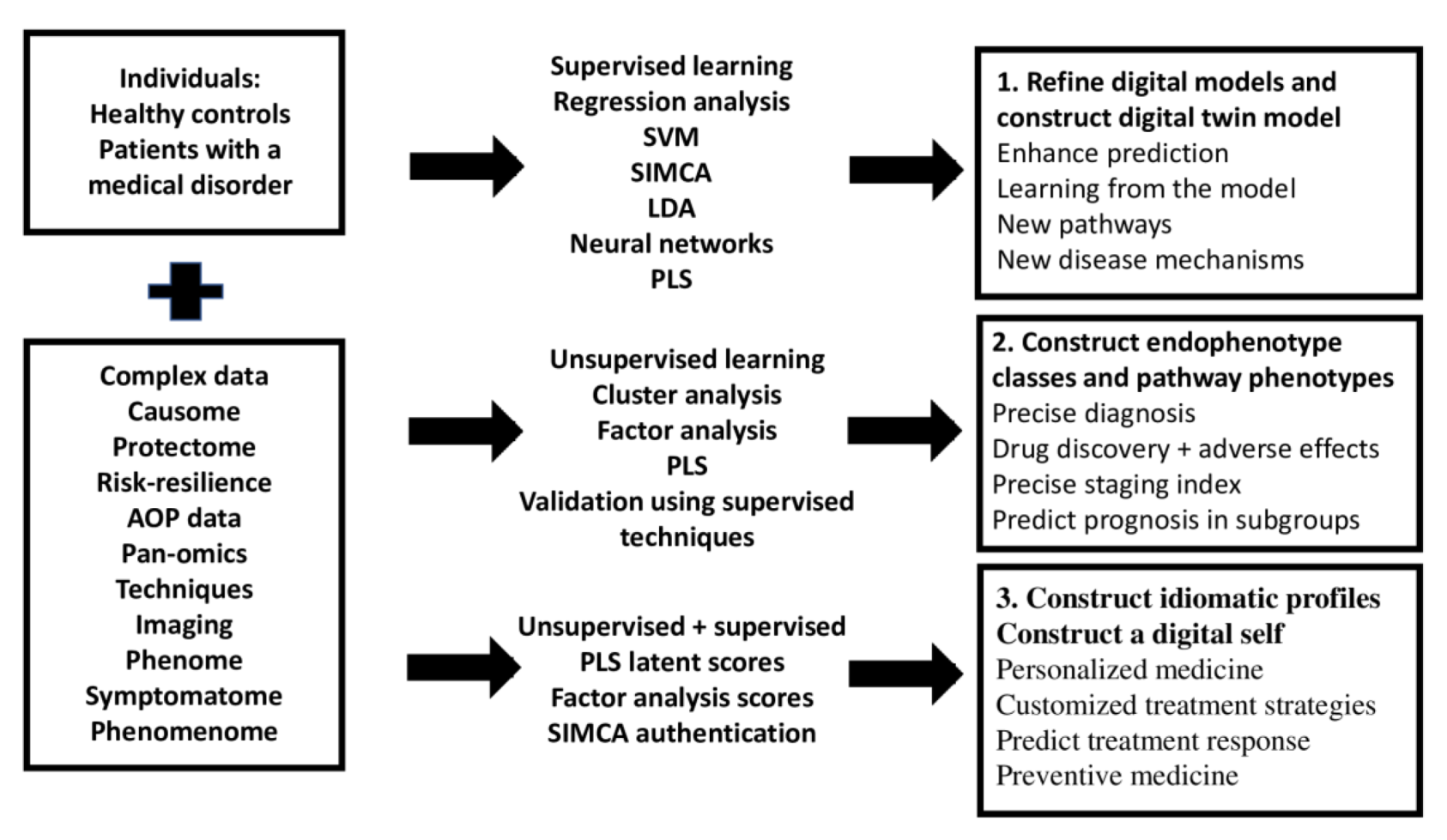
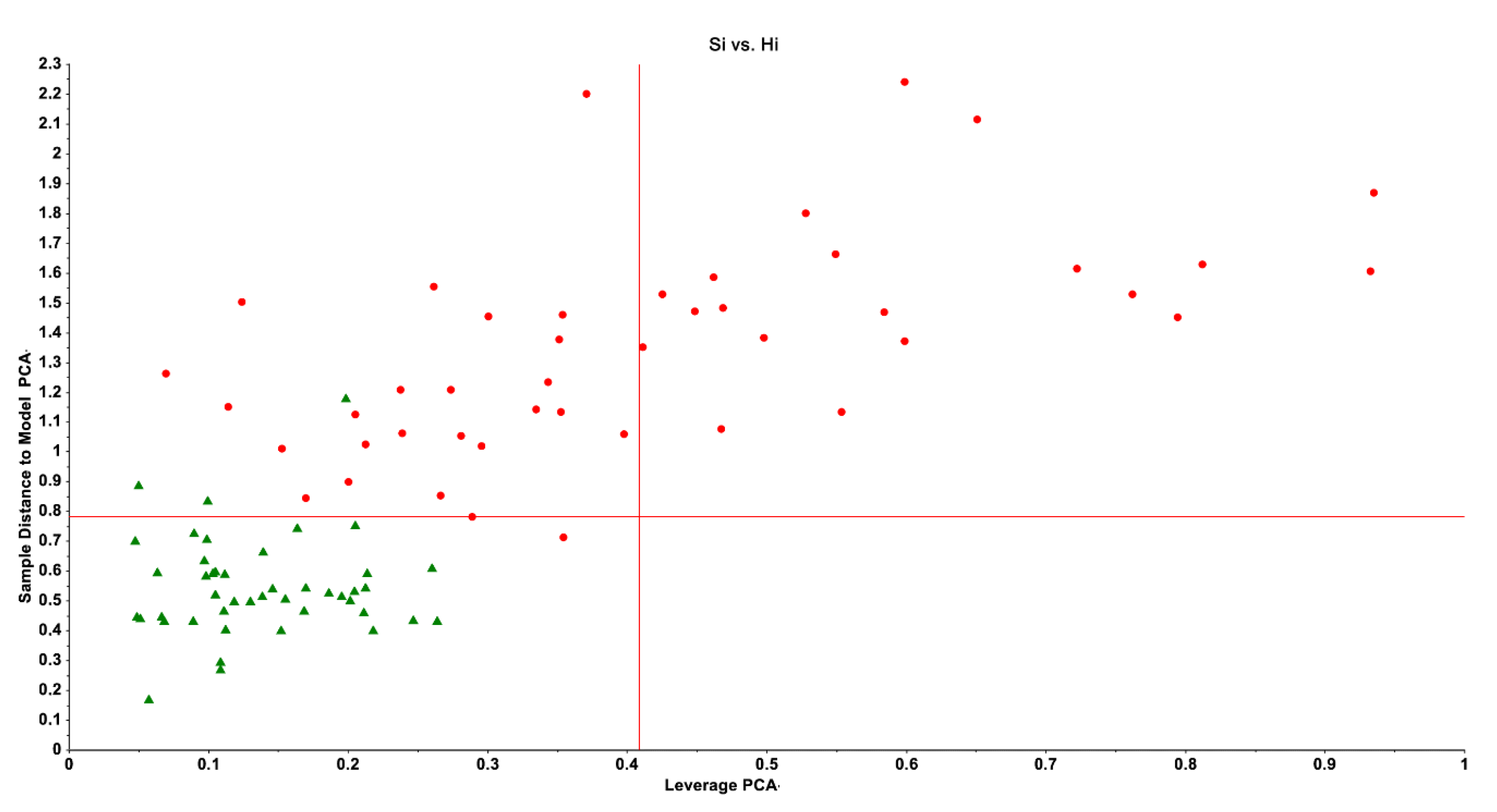

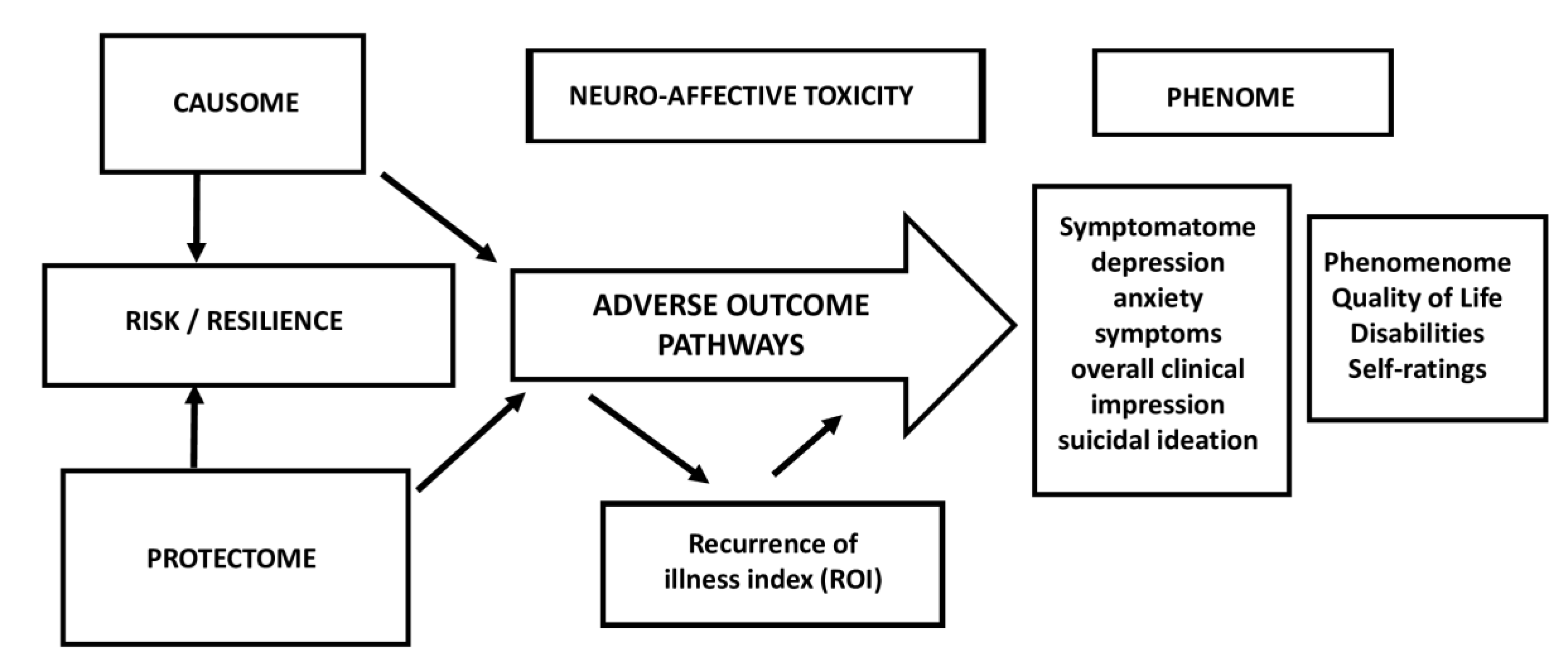
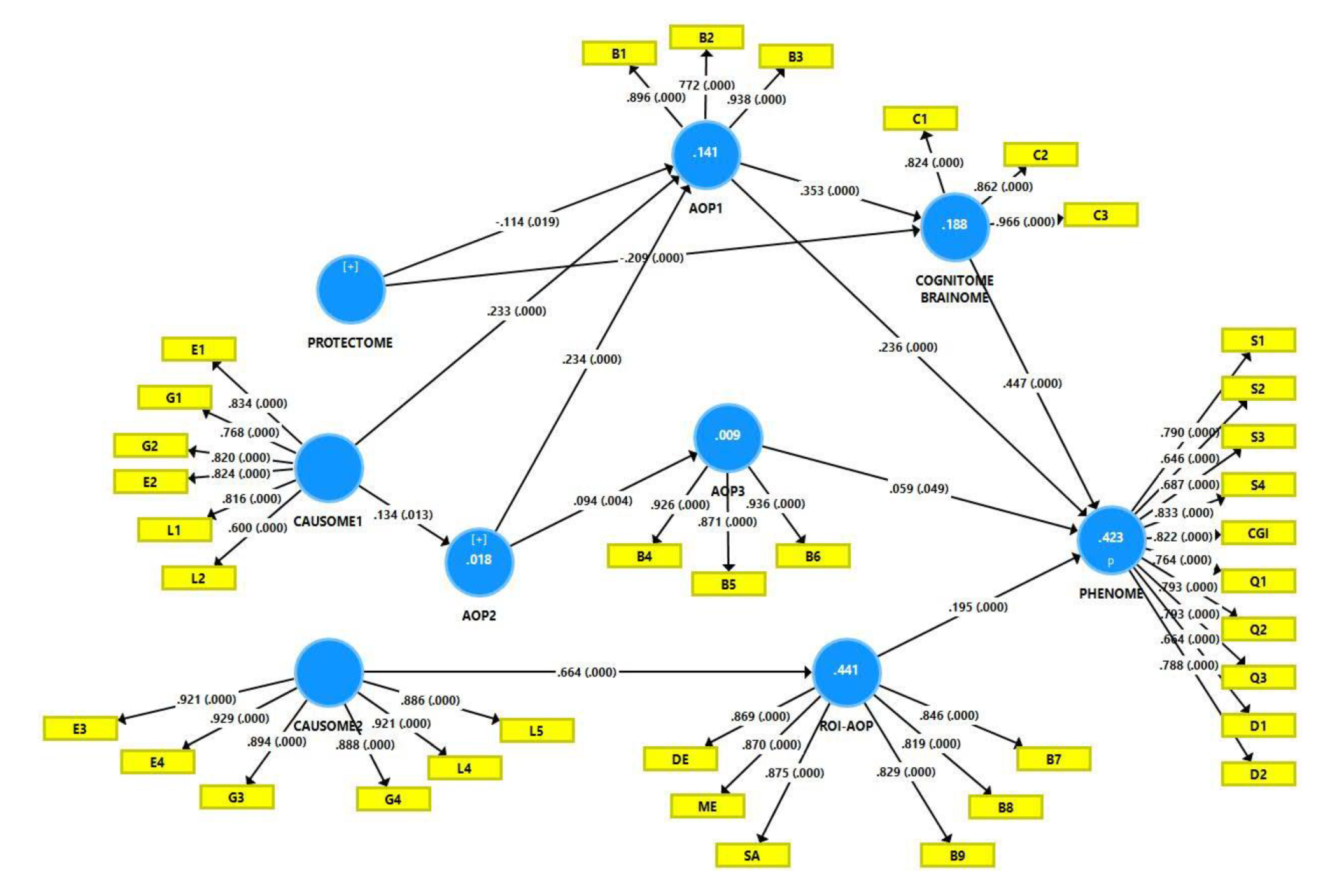
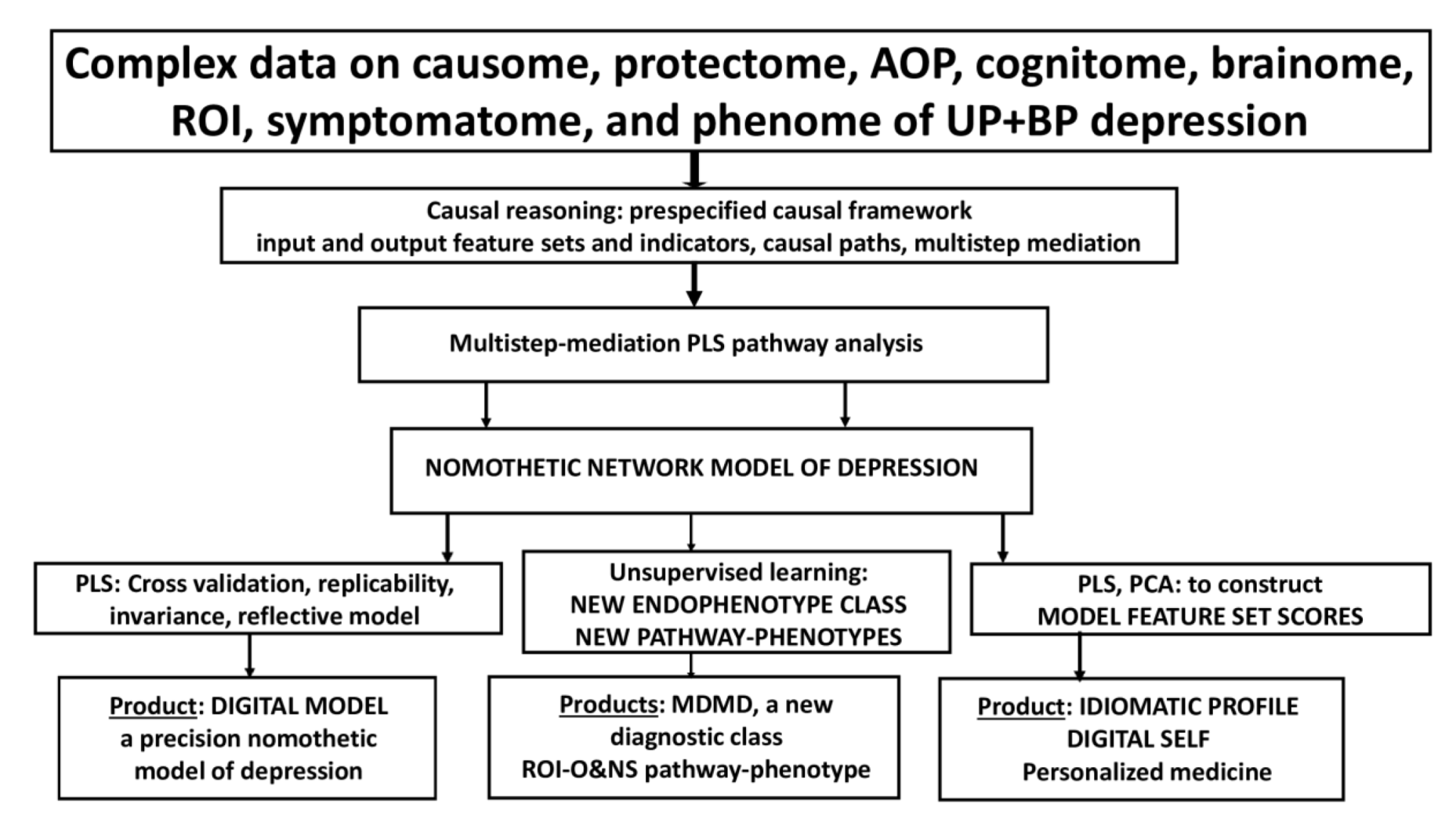

| Supervised Learning | Unsupervised Learning | |
|---|---|---|
| Definition | The use of labeled datasets to train algorithms capable of reliably classifying data or predicting outcomes. These data always consist of paired input (explanatory) and correct output data (dependent data, i.e., predefined classes, or continuous data). Training data are analyzed to produce an algorithm (model) that can be employed to map new cases for example as belonging to the depressed or control class. An algorithm is trained on the input data to detect underlying patterns that are associated with the prespecified output variables. | The computer algorithm learns from unlabeled datasets (training sets). The model determines the similarities or patterns in the input variables without associating these data with the output variables. |
| Examples | Support vector machine Neural networks Soft independent modelling of class analogy Linear discriminant analysis Multiple regression analysis Logistic regression analysis Decision trees Partial least squares path analysis | K-mean clustering K-median clustering Forgy’s clustering Hierarchical clustering Principal component analysis (PCA) + Correlation loadings + PC plot Exploratory factor analysis Correspondence analysis |
| Aims general | Classification Prediction of predefined classes or scale variables Mapping of unknown cases Learn from the data Delineating associations | Discovery of patterns Uncover clusters of cases Learn from the data Uncover associations between input variablesDelineating rules that describe the data |
| Aims precision medicine | Optimizing existing disease models Defining new pathways in the input variables associated with a disease Classifying unknown cases as a patient or control Cross-validation of new endophenotype classes Cross-validation of pathway phenotypes Construct new disease models based on causal associations | Construct new endophenotype classes Construct pathway phenotypes |
| Useful in precision nomothetic psychiatry | Partial least squares path analysis Support vector machine Neural networks Soft independent modelling of class analogy | Clustering techniques PCA PCA plot Exploratory factor analysis |
| Building Blocks Of Depression | Description | Examples in the Current Conceptual Analysis |
|---|---|---|
| Causome | All causal factors that increase risk toward MDMD (genetic, environmental, and lifestyle factors) | Early lifetime trauma (ELT) |
| Protectome | All factors that protect against the onset of MDMD (genetic, environmental, and lifestyle factors) | High high-density lipoprotein cholesterol paraoxonase 1 gene (PON1) |
| Risk-resilience index | Composite based on risk and resilience factors | Early lifetime trauma by PON1 gene interactions |
| AOP (adverse outcome pathways) | Pathways leading to a medical disease | Latent vectors extracted from neuro-oxidative and neuro-immune biomarkers |
| Brainome | Aggregate of brain imaging assessments | Changes in the brain connectome |
| Cognitome | Aggregate of impairments in cognitive functions | Latent vector extracted from executive, attention, and memory dysfunctions |
| Symptomatome | Aggregate of all symptoms, severity of illness, global clinical impression (CGI) | Latent vector extracted from symptoms, severity indices, GCI, suicidal behaviors |
| Phenomenome | Self-experience of the illness | Latent vector extracted from phenomenome data including self-rated disabilities and quality of life |
| Phenome | All symptomatome and phenomenome features | Latent vector extracted from symptomatome and phenomenome data |
Publisher’s Note: MDPI stays neutral with regard to jurisdictional claims in published maps and institutional affiliations. |
© 2022 by the author. Licensee MDPI, Basel, Switzerland. This article is an open access article distributed under the terms and conditions of the Creative Commons Attribution (CC BY) license (https://creativecommons.org/licenses/by/4.0/).
Share and Cite
Maes, M. Precision Nomothetic Medicine in Depression Research: A New Depression Model, and New Endophenotype Classes and Pathway Phenotypes, and A Digital Self. J. Pers. Med. 2022, 12, 403. https://doi.org/10.3390/jpm12030403
Maes M. Precision Nomothetic Medicine in Depression Research: A New Depression Model, and New Endophenotype Classes and Pathway Phenotypes, and A Digital Self. Journal of Personalized Medicine. 2022; 12(3):403. https://doi.org/10.3390/jpm12030403
Chicago/Turabian StyleMaes, Michael. 2022. "Precision Nomothetic Medicine in Depression Research: A New Depression Model, and New Endophenotype Classes and Pathway Phenotypes, and A Digital Self" Journal of Personalized Medicine 12, no. 3: 403. https://doi.org/10.3390/jpm12030403
APA StyleMaes, M. (2022). Precision Nomothetic Medicine in Depression Research: A New Depression Model, and New Endophenotype Classes and Pathway Phenotypes, and A Digital Self. Journal of Personalized Medicine, 12(3), 403. https://doi.org/10.3390/jpm12030403





